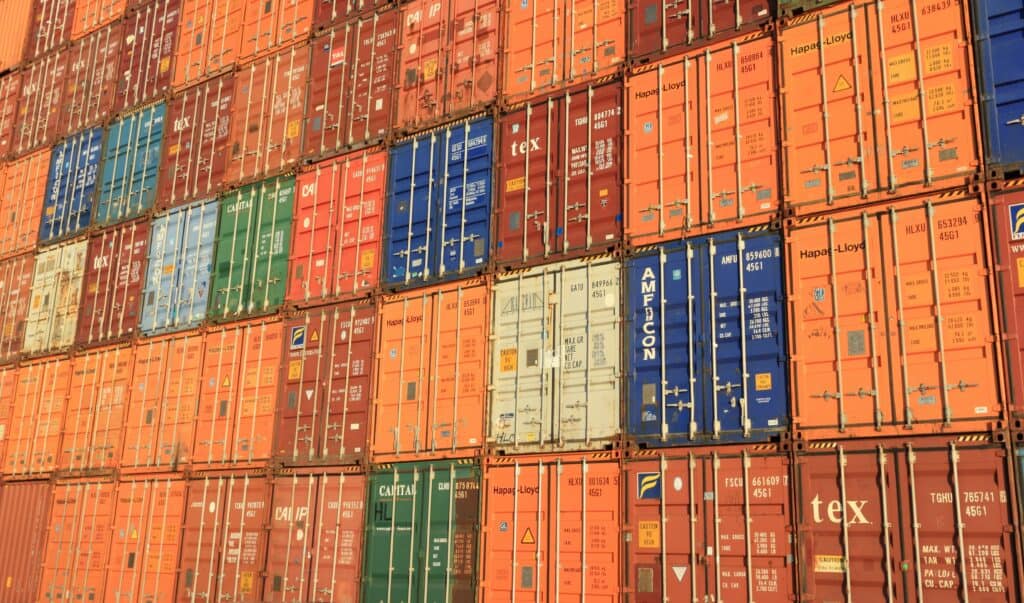A shipping container is a steel container used for shipping cargo. Shipping companies own shipping containers. They lease them to freight shippers for moving full container load (FCL) or less than container load (LCL) cargo. There’s also a growing trend of using refurbished containers to create everything from housing to offices. So there are two answers to the question of shipping container cost: the price to lease and the cost to buy a used container.

This post mainly focuses on shipping container costs for eCommerce companies that lease them to ship freight. But we also dip into the fun world of repurposed cargo containers. For our purposes, we’re referring to standard shipping containers like those used in seagoing freight, usually made of Corten steel.
Cost of shipping a container
The cost of shipping a container depends on many factors, including volume discounts, whether you use a freight forwarder, and market conditions. For example, during the pandemic, a shortage of containers and a sharp spike in demand strained the capacity of the shipping industry. That led to container shipping prices double and triple what they had been only a few months before.
Other elements that can affect pricing include the weight of the goods and any special handling needs, such as wet cargo or hazardous materials.
However, two primary factors affecting shipping container cost are container size and where you send it to and from.
Container size
The 40-foot and 20-foot containers are the most common sizes for delivering goods to eCommerce fulfillment centers and distribution centers. Both sizes are large enough to hold a substantial amount of freight and fit into loading slots on container ships. Tractor trailers and rail cars that pick up containers for ground transport are also built to hold 20- and 40-foot containers.
While smaller containers in the 10-foot standard size or a custom size may cost less to ship overall, they may be more expensive than 20-foot and 40-foot containers because their non-standard sizes make them harder to load.

Origin and destination
Forbes reported in January 2023 that the cost to move a shipping container domestically in the U.S. ranged from $1,200 to more than $7,500. The average cost was around $3,000.
For international shipping, your shipping container costs will include the movement to the port, ocean shipping, and moving the container from the port to your warehouse in the U.S. Other costs can include tariffs and customs, fees charged for loading and unloading intermodal freight (especially for LCL freight, which may shift containers multiple times during its journey), and detention and demurrage charges.
International shipping fees vary widely depending on the distance to and from the port at each end of the journey and the origin and destination ports. For example, sending a container from Yangshan Deep Water Port in Shanghai to the Port of Los Angeles is faster and less expensive than shipping the same container from Shanghai to New York.
To get shipping container pricing for your FCL or LCL needs, get help from your fulfillment partner, manufacturer, or freight forwarder, or work directly with a shipping company. Several freight companies have online calculators that allow you to get instant container freight quotes. Use those as a ballpark and confirm once you have all the details in place.

How to control shipping container costs
While shipping companies set the price to send a full container load of freight, several factors can affect your container shipping costs. The difference might not be a lot per container, but it adds up over time. Taking simple steps to optimize your supply chain is a terrific way to improve your profit margins and bolster your brand’s success.
Palletizing vs. floor loading
There are two ways to load products into a container — on pallets or floor-loaded — and there are pros and cons to each method.
Floor loading creates more container space for merchandise by eliminating pallets. If shipping prices are high, fitting extra cargo into each container may save enough to make the practice worth it. Plus, some bulky cargo may not be suitable for palletizing, so floor loading is the only option.
However, floor-loaded goods are harder to secure and thus have a greater risk of damage during transport. And floor-loaded cargo is more expensive to unload because fulfillment warehouses must unload them by hand. Some warehouses, such as Amazon FBA, won’t accept floor-loaded containers or will only take them under specific circumstances.
Palletizing is securing products onto a pallet, usually made from sturdy wood, with shrink wrap or by strapping down (or both). Pallets lift cargo off the floor of the container, protecting products from potential damage if a container isn’t watertight. Warehouse workers can move palletized merchandise using forklifts, so unloading container freight on pallets requires less staffing and is quicker and easier. Getting your manufacturer to palletize your products can be an excellent way to save on container shipping.

Freight forwarding
A freight forwarding company will have relationships with many shipping companies because of the volume of cargo it manages. Although you’ll need to pay the freight forwarder for their services, they may be able to get you better pricing and faster passage.
Strategic warehouse locations
When choosing your fulfillment warehouse locations, the first consideration is reaching your U.S. customers quickly with affordable domestic parcel shipment. But another consideration is how easy it will be to transport shipping containers with your products to the warehouse.
A warehouse near a port is advantageous for freight delivery but has significant drawbacks for order fulfillment. A warehouse in a more central location for sending orders can still give you excellent port access. For example, Red Stag Fulfillment’s Tennessee warehouses are near a rail line that can easily transport containers from port to warehouse. Look at rail and trucking options when choosing your fulfillment warehouses.
Avoiding detention and demurrage
Detention and demurrage are charges the shipping company adds if you fail to return a container to port within a specific time frame. You can avoid these extra fees by carefully managing your supply chain so transport doesn’t lag and choosing warehouses close to the port. Another option is to book the container to its final destination at the warehouse so fees don’t accrue.

Cost to purchase a used shipping container
Shipping containers aren’t just for transporting freight anymore. People are using the sturdy metal structures as storage units, to build tiny houses, and even to create multistory buildings by putting multiple containers together. Storage containers have become a cost-effective way to to create small living, working, and storage units.
Storage container prices start around $2,500 for a used storage container and can go up to $20,000 for a new shipping container. High cube containers cost more than the standard 8’6” version, and 40-foot containers cost more than 20-foot. Prices can also vary depending on the condition (for a used container). And add delivery fees to your shipping container costs because you’ll need it hauled to your location.

One partner for all your shipping needs: Red Stag Fulfillment
Red Stag Fulfillment wants to make your eCommerce fulfillment perfect, and helping you improve your supply chain operations is part of that process. We work hard to get our clients the best prices on order delivery with major carriers, and we can also connect you with freight forwarders and other resources to ensure your inbound freight runs smoothly.
Speed and efficiency are at the heart of excellent order fulfillment, and Red Stag’s industry-leading 3PL services give your business the foundation it needs to succeed in eCommerce.
More about container shipping:
- Container Consolidation: Lowering Costs Without Losing Control
- What You Need to Know About Floor-Stacked Containers
- Unloading Floor-Loaded Containers: An ECommerce Guide

Shipping container FAQs
How do I ship by container?
Container shipping usually starts at a factory or distribution center. Your supplier will load your goods into a container. The manufacturer may take responsibility for getting the container to the nearest port, or you might need to arrange to pick it up from the factory. From the port, it’s your responsibility to arrange transportation to the U.S. Choose the port closest to your fulfillment center and from that port to the warehouse. International container shipping is a complex process, and many eCommerce companies use freight forwarders to help them manage it.
What are the standard shipping container sizes?
The most common shipping container sizes in international transport are 40-foot and 20-foot. The standard width is 8’, and the standard height is 8’6”. However, you can also rent 10-foot shipping containers and high cube 20-foot containers that are 20’ tall. Standard shipping container sizes are essential because they make it easier to load and secure carge on container ships. Standard size also fit truck and rail cars for multimodal shipping.
Are FCL and LCL my only options for international freight?
No. You can also ship internationally via air freight. However, the most common ways to move goods internationally are full container load and less than container load freight.
Are shipping containers only for ocean freight?
No. Shipping containers also transport domestic freight on semi-trucks and by rail.






